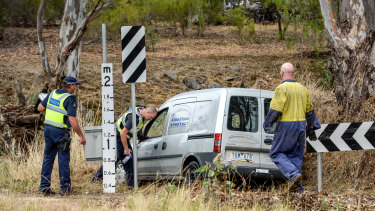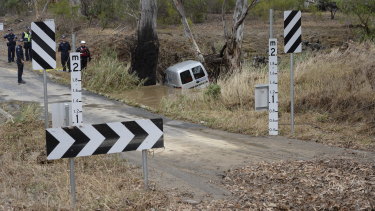A much-loved Seymour baker died when he was swept away in floodwaters after a council employee fell asleep before sending anyone to deploy warning signs.
Floodwaters had inundated the Seymour area in central Victoria in early January, 2016, causing Whiteheads Creek to rise across Delatite Road.
Flash flooding claimed the life of Seymour baker Max Loweke in January 2016.
But while local emergency services rushed to flooding across the nearby Goulburn Valley Highway, little was done to warn motorists of rising waters at Delatite Road, where witnesses said they saw rising water reach 1.8 metres on flood markers.
About 1.50am on January 4, 63-year-old grandfather Max Edward Loweke – whose agility was affected by spinal surgery and a prosthetic knee, which likely inhibited his ability to free himself from his car – inadvertently drove into the swollen creek on his way to work.
There, less than one kilometre from his home, he was swept away in the dark and drowned in his car as SES volunteers desperately tried to rescue him.
In findings handed down this week, coroner Darren Bracken said ”water over road” signs that could have warned Mr Loweke of the dangers that lie ahead were instead left lying folded and locked on the side of the road because only Mitchell Shire council workers had the keys.
Police recover the van.Credit:Justin McManus
“The amount of water flowing over the ford was a serious danger to road users,” Mr Bracken said. “Throughout January 3 and 4 … these signs were not deployed.”
Geoff Dixon, a longtime friend of Mr Loweke, said this week the Seymour community was still grieving for their mate.
“He was a really loved person, Max. He was a family man first, a businessman second and then he was a community man next,” Mr Dixon said.
“He donated and gave what he could to charities around the area and he just wanted to make you laugh. You walk past his old shop today and still say ‘how are you going Maxy?’ You still get hurt by it.”
Police on the scene at Whiteheads creek in Seymour, where a man drowned after driving his car into flood waters. Credit:Justin McManus
Water had begun to flood the road from about 8.30pm on January 3, 2016.
Witness Madalin Duna told the coroner it appeared smooth, like glass, and she was unable to tell it apart from the asphalt.
At 10.27pm, Ms Duna called triple zero to alert them to the danger, offering to use her car to block the road until help arrived, but was told there was “no need for that”.
Between 11pm and 1am, police and SES volunteers attended the ford a number of times, phoning triple zero in an attempt to get council officers to attend. Each time the officers returned to the flooding event at the Goulburn Valley Highway on the other side of town, leaving the flooded ford unguarded.
One officer told the coroner he didn’t want to cut the sign padlocks and face having to explain to the council why he had damaged their property.
In a statement provided to the coroner, a council employee said she responded to flooding calls in the Seymour area before going to sleep between 10pm and 11pm. She said she was woken by her telephone about midnight requesting signage in Delatite Road.
A transcript of the call said someone had requested signage at Delatite Road about 10.30pm. The employee, who The Age has chosen not to name, told the operator she didn’t know if the job had been completed.
After hanging up, the employee messaged the council’s road maintenance coordinator, who provided the name of a person to call.
”Unfortunately, while [the employee] was putting her son to bed, she fell asleep herself without having sent anyone to the ford,” Mr Bracken said.
About 1.50am, Mr Loweke drove his Best Choice Bakery van into the ford, three and a half hours after the first call to council requesting signs be placed on Delatite Road and a little less than two hours after the employee was asked to deploy signage.
“Had Delatite Road been closed, or indeed the signs deployed shortly after 10.33pm, it is at least possible that Mr Loweke’s death would have been prevented,” Mr Bracken said.
Mr Loweke said knowing his friend’s death was preventable made coming to terms with what happened even more difficult.
“If someone or something had been there blocking the road he wouldn’t have gone that way,” he said.
Automatic water level detectors have since been installed at the ford to notify police and SES when flooding becomes deep.
Mitchell Shire Council has also changed the way it manages staff in charge of its after-hours response.
The coroner has recommended that emergency services now conduct more mock emergencies in regional areas and that when an emergency is being managed, all involved be explicitly informed of which organisation is in control.
He also called for those who are to be appointed incident controller or police commander roles during emergency events undergo formal risk assessment training.
A Victoria Police spokeswoman said the organisation would now review and consider the coronial findings.
The Morning Edition newsletter is our guide to the day’s most important and interesting stories, analysis and insights. Sign up here.
Most Viewed in National
From our partners
Source: Read Full Article





